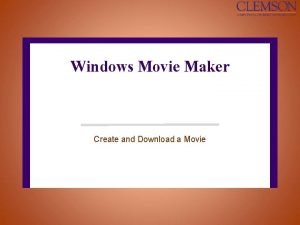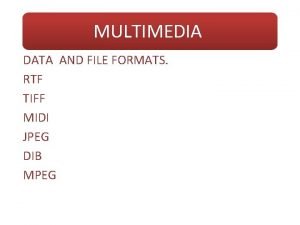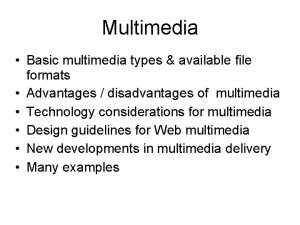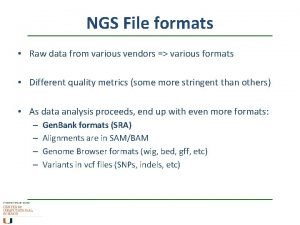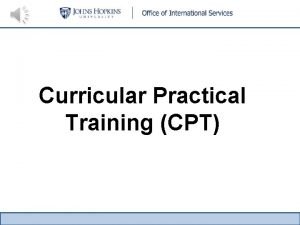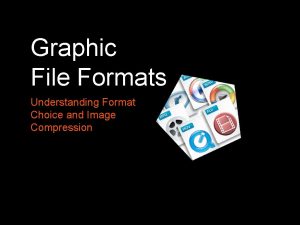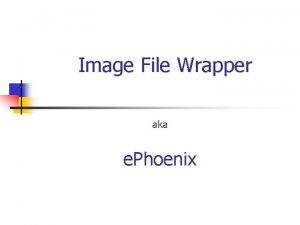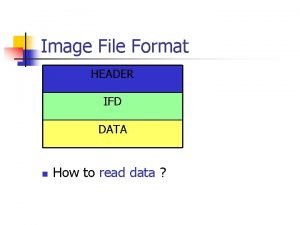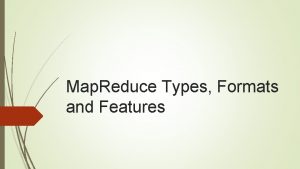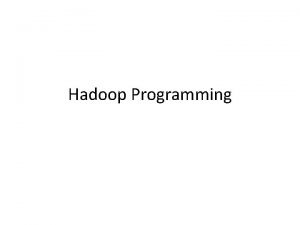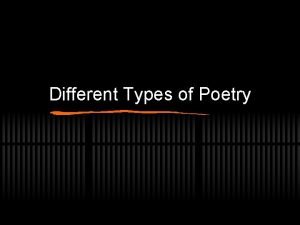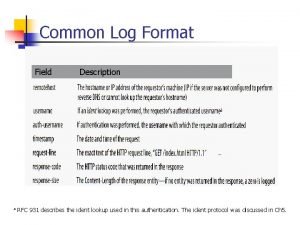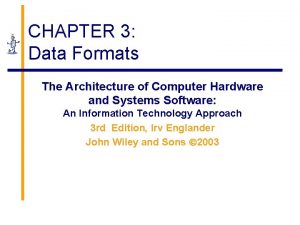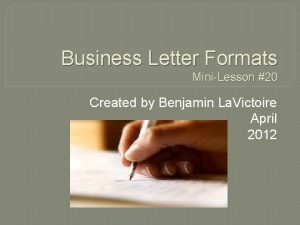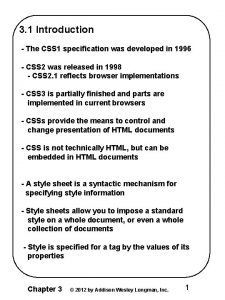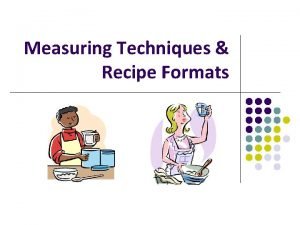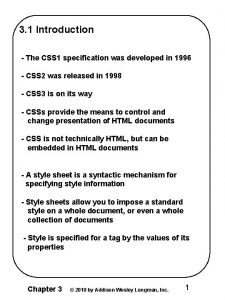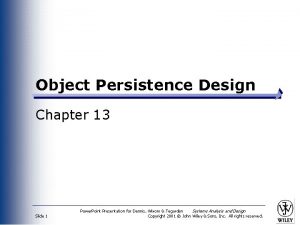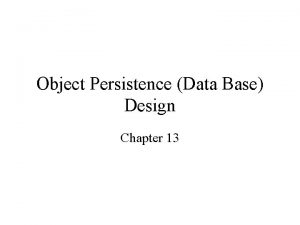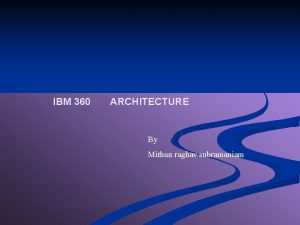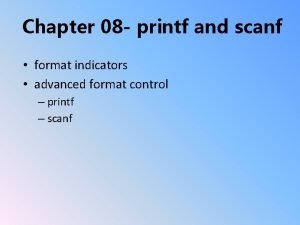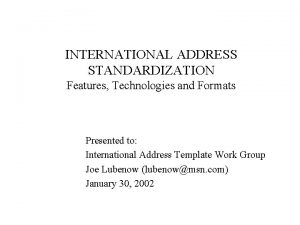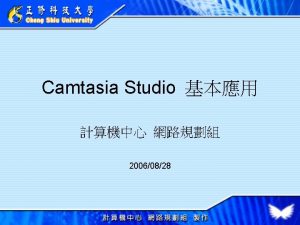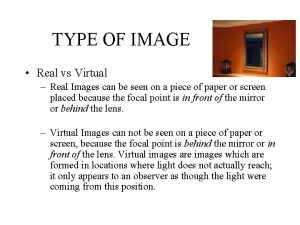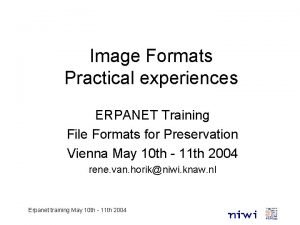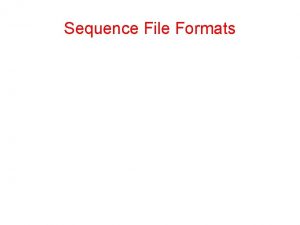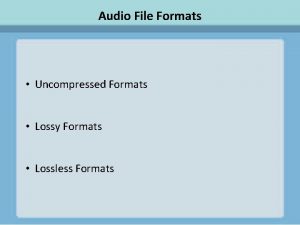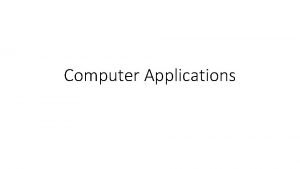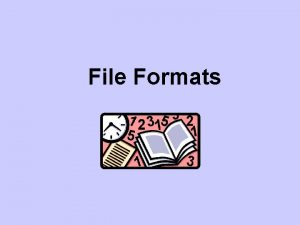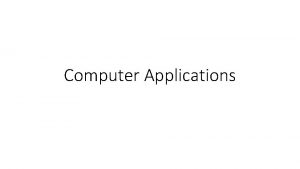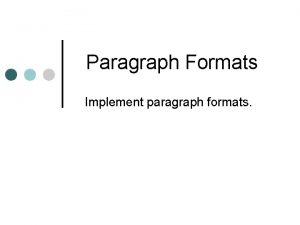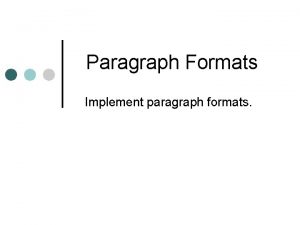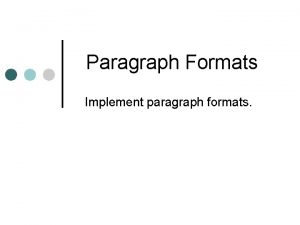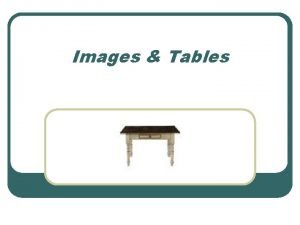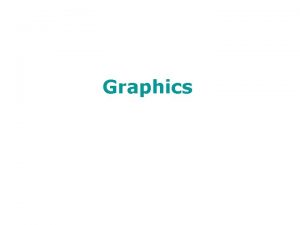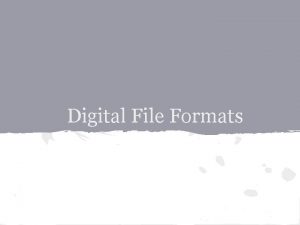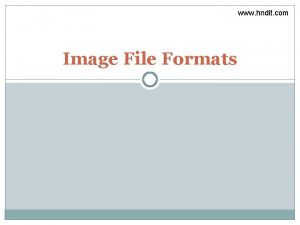Image Formats Practical experiences ERPANET Training File Formats










































- Slides: 42

Image Formats Practical experiences ERPANET Training File Formats for Preservation Vienna May 10 th - 11 th 2004 rene. van. horik@niwi. knaw. nl Erpanet training May 10 th - 11 th 2004

"Theory without practice is empty. Practice without theory is blind" John Dewey Erpanet training May 10 th - 11 th 2004

Outline • Theories on digital preservation • What are image formats? • Practices to preserve images Erpanet training May 10 th - 11 th 2004

Theories on digital preservation • Based on assumptions such as: – – – XML is the only durable storage format Metadata is essential Standards will do the job Data storage media is robust Registries are essential Etc. • Only the future can judge which assumptions were right. . . Erpanet training May 10 th - 11 th 2004

Digital preservation solutions • • • Format registry (e. g. GDFR) Format identification (e. g. Jhove) Digital archiving (e. g. VERS) Distributed storage (e. g. OAI, Lockss) Emulation (e. g. UVC) Etc. Erpanet training May 10 th - 11 th 2004

Digital preservation practices • Several organisations committed themselves to preserve digital objects. • Relatively recently started (but scientific data archives, holding datasets, exist for more than 25 years!) • Examples: – NARA: Transfer of permanent E-records – KB the Netherlands: e-Depot – Harvard University: DRS – Etc. • In common: commitment! Erpanet training May 10 th - 11 th 2004

Image file preservation T. Thibodeau ‘Overview of technological approaches to digital preservation and challenges in coming years’ (CLIR report) <http: //www. clir. org/pubs/reports/pub 107. pdf> Erpanet training May 10 th - 11 th 2004

What are images? “Graphics files can be considered as files that store any type of persistent graphics data (as opposed to text, spreadsheet, or numerical data, for example), and that are intended for eventual rendering and display. ” (Murray & van Ryper, Encyclopedia of graphics file formats (O’Reilly) 1994) Erpanet training May 10 th - 11 th 2004

Why are there so many different graphic file formats? • There a number of fundamental different types of graphical data – raster data (sampled values) – geometry data (mathematical description of space) – latent image data (data transformed into useful images by some algorithmic process) • To prevent usage beyond control of the developer (Who remembers Kodak. Photo CD? ) • Wide range of design principles and ‘memory’) Erpanet training May 10 th - 11 th 2004 (Mainly ‘speed’

Raster images / bitmap Digital preservation Creation of derivatives Three steps in the photographic process Erpanet training May 10 th - 11 th 2004 Digital master file

The first scanner! According to Kirsch (R. Kirsch, ‘SEAC and the start of image processing at the National Bureau of Standards. In: Annals of the history of computing, IEEE, vol. 20 (1998), p 7 -13. ) Erpanet training May 10 th - 11 th 2004

And (a printer output of) the first digital image. 1956. Erpanet training May 10 th - 11 th 2004

Several decisions made by the developers of the first scanner have influenced engineering practice ever since, e. g. the usage of rectangular arrays of square pixels. Sixteenth century mosaic containing 80 x 46 carefully coloured and shaped tiles (ref. Kirsch 1998) Erpanet training May 10 th - 11 th 2004

Digitising the mosaic with even more square pixels (100 x 58) results in inferior image Erpanet training May 10 th - 11 th 2004

Digital raster images require a lot of storage memory and processing speed Storage required = phd x pvd x pd x cr phd = number of pixels in horizontal dimension pvd = number of pixels in vertical dimension pd = pixel depth (determines the number of colours a pixel can get) cr = compression ratio Erpanet training May 10 th - 11 th 2004

800 pixels File size = 800 X 600 X 24 8 = 1. 440. 000 bytes 600 pixels RGB = Additive primary colours. Any colour can be created by adding R(ed), G(reen) and B(lue) in the correct proportions. The red, green and blue component values define a colour in the ‘RGB colour space’. Erpanet training May 10 th - 11 th 2004 ‘R’ decimal value =186 ‘G’ decimal value =70 ‘B’ decimal value =73 = ‘Red’

1 pixel in RGB colour space requires 3 bytes Erpanet training May 10 th - 11 th 2004

Some figures on images • Survey 1999: 141 institutes all over Europe keep about 120. 000 photographic items (average collection is 800. 000 items) (source: E. Klijn and Y. de Lusenet, In the picture. Preservation and digitisation of European photographic collections. Amsterdam (ECPA) 2000) • “Estimation” 2002: about 9. 000 digital historical photographs are available online (Source: D. Mattison, ‘Images on the web’ in: Searcher issue 5 (2002) Erpanet training May 10 th - 11 th 2004

Is conventional imaging durable? “… the daguerreotype image was as fragile as a butterfly’s wing, fleeting and much more difficult to reproduce than an engraving. There was a general consensus that photography would become a force only once it could produce durable, infinitely repeatable images… This ambition had been partially achieved by the end of the 19 th century, but did not reach its full commercial maturity until later. ” (S. Aubenas, ‘The photography in print. Multiplication and stability of the image’ in: M. Frizot (ed. ) A new history of photography. Köln 1998 p. 225) And what about digital imaging? “Digitization of cultural artifacts should provide a lasting electronic record for scholarly and universal access, preservation, and study. At the present time, however, digitization projects are proceeding without established methods of recording precise conditions of digitization. ” (Report of DELOS-NSF working group on digital imagery for significant cultural and historical materials. 2003. <http: //delos-noe-iei. pi. cnr. it/activities/internationalforum/Joint. WGs/digitalimaging/Digitalimaging. pdf>) Erpanet training May 10 th - 11 th 2004

‘Building blocks’ for the long term preservation of digital images • Building block: procedures, tools, standards, specifications and guidelines available to realize the long term access of digital images. 1. Standard graphics file formats 2. XML data format 3. Metadata Erpanet training May 10 th - 11 th 2004

Assumptions • Standards are durable, e. g. image file format standards • Digital data encoded in the XML data format is durable data • Metadata on digital objects is essential in order to understand process digital objects in the future Erpanet training May 10 th - 11 th 2004

Features of standard image file formats • • • Used by large community during a considerable period of time Specifications must be in the public domain or published by SDO Wide range of systems has to support the format No data compression (loss of quality / higher risk) Must contain facilities to store preservation metadata Must enable coding of all significant characteristics of analogue original Erpanet training May 10 th - 11 th 2004

Durability requirements and raster file formats Raster file requirements T I F F J P E G G I F P N G 1 Used by a large community over a long time + + + - 2 File format specification is published + + 3 Supported by a wide range of applications + + 4 Supports un-compressed / single page images + - - - 5 Facilities for preservation metadata + - - + 6 Enables “full informational capture” + - - + File formats described in Murray & van. Ryper, Encyclopedia of graphics file formats (O’Reilly) published in 1994 and still used in 2004. Erpanet training May 10 th - 11 th 2004

XML: e. Xtensible Markup Language • Information interchange format • Standard, developed by World Wide Web consortium (http: //www. w 3 c. org/xml) • Application independent • No pre-defined markup tags (extensible) • Both human and machine understandable Erpanet training May 10 th - 11 th 2004

Durable encoding of the bitstream 2 1 0 0 1 2 Bi-tonal bitmap consisting of 9 pixels <bitmap> <pixel> <position> <horizontal>0</horizontal> <vertical>0</vertical> </position> <colour>black</colour> </pixel> <position> <horizontal>0</horizontal> <vertical>1</vertical> </position> <colour>white</colour> </pixel>. . . </bitmap> Bitmap expressed in XML Erpanet training May 10 th - 11 th 2004

Digital image expressed in XML • Expression of content model in XML • Elements and attributes that are part of the bitstream, e. g. standardized color coding of pixels • Binary to XML conversion • Conversion of image format (e. g. TIFF) into XML • XML to binary conversion • In the future Erpanet training May 10 th - 11 th 2004

Components of preserved bitstream in XML format Preserved bitstream Structure of XML file, e. g. XML Schema raster image in existing graphic file format Raster image in XML format raster image in future graphic file format Components of preserved bitstream in XML format Erpanet training May 10 th - 11 th 2004

Methods available to express image in XML format • • • Bit stream syntax description language (BSDL) Universal Virtual Computer (UVC) Formal language for audio-visual object representation (Flavor / Xflavor) Erpanet training May 10 th - 11 th 2004

Bitstream syntax description language (BSDL) • Each format requires specific content model • Thorough knowledge required on the way the bits are organized • Absence of “binary to XML” and “XML to binary functionality Erpanet training May 10 th - 11 th 2004

Example: BSDL Schema of a JPEG 2000 image Erpanet training May 10 th - 11 th 2004

Universal virtual computer (UVC) • Bitstream representing the data is stored together with the logical view of the data • Also specification to process data on a future platform is archived • Processing specification based on UVC (= interpreter independent of computer architecture) Erpanet training May 10 th - 11 th 2004

Formal language for audio-visual object representation (Flavor / Xflavor) • Developed for the description of binary multimedia objects • Xflavor: application of XML in order to simplify interoperability among different applications Erpanet training May 10 th - 11 th 2004

Comparison of 3 methods Binary to XML conversion Content model in XML to Binary conversion BSDL - ++ - UVC ++ + + + XFlavor - task is available in system design + task can be performed with the method, but adjustments are required to enable the processing of digital master images ++ task can be performed by the method Erpanet training May 10 th - 11 th 2004

Metadata • Three ways to store metadata on digital images: 1. As part of the image (e. g. File header) 2. In separate database 3. In file system (/images/thumbnails/2003/05/…) Erpanet training May 10 th - 11 th 2004

Application of preservation metadata • Two methods: – Create from scratch – (Re)use existing data elements (data element: unit of data for which the definition, identification, and permissible values are specified by means of as set of attributes (ISO/IEC 11179)) Erpanet training May 10 th - 11 th 2004

Some Metadata elements sets • NISO Z 39. 87 -2002/AIIM 20 -2002, Data Dictionary – Technical Metadata for Digital still images, 2002 <http: //www. niso. org/standards/resources/Z 39_87_tri al_use. pdf> • EXIF 2. 2, Exchangeable image file format for digital still cameras, April 2002 <www. exif. org> • Sepia. DES (Sepia Description Element Set): metadata element set for historical photographic collections http: //www. knaw. nl/ecpa/sepia. html • Etc. Erpanet training May 10 th - 11 th 2004

Metadata registries Provides data elements for Metadata Registry “Mix & match” principle Accessible via Results in Application profiles Erpanet training May 10 th - 11 th 2004

Conclusions • TIFF image file format often used as format for digital master image (Adobe Systems Incorporated, TIFF revision 6. 0, Final – June 3, 1992 <http: //partners. adobe. com/asn/developers/pdfs/tn/TIFF 6. pdf>) • Bitstream in XML format: more research required • Preservation metadata: application profiles & registries help to ‘discriminate exactly what we know vaguely’ Erpanet training May 10 th - 11 th 2004

Practices • Usage of microfilm as archival medium! • Risk management (G. Lawrence, R. Kehoe, O. Rieger, W. Walters, and A. Kenney, Risk management of digital information: A file format investigation (Washington, DC: CLIR, 2000) <http: //www. clir. org/pubs/reports/pub 93/contents. html>) • Practice depends on project (characteristics of originals, budget, skills, purpose, etc. ) Erpanet training May 10 th - 11 th 2004

(Example) Digital image of historical photograph + Metadata This digital reference image is created by London Metropolitan Archives (LMA). The image is a derivative of a digital master file stored on CD-ROM and archived by LMA. The original photograph on which this image is based is stored under inventory number SC/PHL/02107976/1167248. 0 X 73/73. The name of the image is L 13071 AR. The image is stored in the “jpeg” format. The copyright is owned by LMA. The image has the following title: “Open Spaces Committee on a visit”. The original photograph is created in 1884. The reference image is 400 pixels wide in the horizontal dimension. The original photo is taken by an unknown photographer employed by the Greater London Council. A reproduction of this image on basic paper (100 gms paper printed @ 360 dpi) costs £ 2. 60. A photographic print (from negative as per LMA reprint service) costs from £ 12. 75. Etc. etc. Erpanet training May 10 th - 11 th 2004

(Example cont. ) Metadata in XML format according to DC syntax <metadata> xmlns: dc=“http: //purl. org/dc/elements/1. 1/” <dc: title> lang=”eng” Open Spaces Committee on a visit </dc: title> <dc: description> Metropolitan Board of Works: Parks, Commons and Open Spaces Committee on a visit </dc: description> <dc: date> 1884 </dc: date> <dc: creator> Greater London Council </dc: creator> <dc: identifier> http: //www. lma. uk/data/images/L 13071 AR </dc: identifier> <dc: publisher> London Metropolitan Archives </dc: publisher> <dc: keywords> Parks </dc: keywords> </metadata> Erpanet training May 10 th - 11 th 2004

Example (cont. ) Using distributed architecture as part of digital archiving solution for digitised historical photographs. Erpanet training May 10 th - 11 th 2004
 Erpanet
Erpanet File-file yang dibuat oleh user pada jenis file di linux
File-file yang dibuat oleh user pada jenis file di linux Movie maker file formats
Movie maker file formats Rtf in multimedia
Rtf in multimedia File formats in multimedia
File formats in multimedia File formats in multimedia
File formats in multimedia Ngs file formats
Ngs file formats Hadoop file formats
Hadoop file formats Difference between logical file and physical file
Difference between logical file and physical file Fungsi sistem file
Fungsi sistem file Distributed file system definition
Distributed file system definition Markup tag tells the web browser
Markup tag tells the web browser In a file-oriented information system, a transaction file
In a file-oriented information system, a transaction file Ois jhu opt
Ois jhu opt Graphic image file
Graphic image file Image file wrapper
Image file wrapper Image file header
Image file header Compare stl and slc file format
Compare stl and slc file format Mapreduce types and formats
Mapreduce types and formats Input formats in hadoop
Input formats in hadoop Quatrain example
Quatrain example Common log format
Common log format Data formats in computer architecture
Data formats in computer architecture Business writing formats
Business writing formats The simplified style business letter has
The simplified style business letter has Radio station music formats
Radio station music formats Memo spacing
Memo spacing Style specification formats
Style specification formats Action recipe format
Action recipe format Style specification formats
Style specification formats Object persistence formats
Object persistence formats Object persistence formats
Object persistence formats Instruction format of ibm 360
Instruction format of ibm 360 Scanf formats
Scanf formats International address standardization
International address standardization Power point video formats
Power point video formats Small group stages formats and culture
Small group stages formats and culture Data formats in computer architecture
Data formats in computer architecture Real vs virtual images
Real vs virtual images Real images vs virtual images
Real images vs virtual images Image transform in digital image processing
Image transform in digital image processing Linear position invariant degradation
Linear position invariant degradation Arithmetic coding in digital image processing
Arithmetic coding in digital image processing


